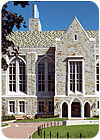
Shepley Bulfinch Richardson and Abbott (SBRA) used natural stone for a broad range of institutional projects. At Boston College, the firm used rough-cut stone in a Gothic style for Higgins Hall, one of several projects on campus completed by SBRA.
Founded in 1874 by renowned American architect Henry Hobson Richardson, Shepley Bulfinch Richardson and Abbott (SBRA) is one of the oldest continuously practicing architectural firms in the nation and the oldest in Boston, MA. Today, the national design practice, which provides architecture, planning and interior design services to the education, healthcare, science, corporate and public markets, has grown to include more than 200 members. The firm's work spans across the U.S. as well as in parts of South America, Chile and the United Kingdom.
After almost a century as a partnership, SBRA was incorporated in 1972. A Board of Directors, including four principals, supported by approximately 40 senior associates and associates, manages the firm, which is categorized into three primary practice areas - healthcare, education and science. As a full-service resource for its clients, SBRA supplements its core architectural, planning and interior design services with special expertise in historic preservation, restoration and renovation, and building envelope technology.

The use of stone at Higgins Hall continues to the interior atrium space.
Additionally, the firm has been honored with more than 50 design awards during the past decade. In 1997, SBRA was named one of America's best-managed firms in a survey by Architectural Record magazine. Members of SBRA take pride in upholding the strong tradition of their firm - building long-lasting relationships with clients and working with high-quality materials such as natural stone.
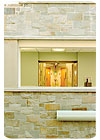
“The whole atrium color scheme is derived from the color of the stone,†explained Elizabeth “Zibby†Ericson, FAIA, Principal at SBRA. “That created a warmth and vital experience, visually.â€
- Elizabeth “Zibby†Ericson, FAIA, Principal, senior designer and member of the firm's Science Practice Group
- Ralph Jackson, FAIA, Principal and senior designer for the Education and Science Practice group
- Thomas Kearns, AIA, Principal, Chair, Education Practice Group

At Case Western Reserve University in Cleveland, OH, the firm used two varieties of granite for the Kent Hale Smith Engineering and Science Building, including Lake Placid Blue granite from New York as well as a white granite variety. “I remember the Lake Placid Blue was a race with Mother Nature, because they were quarrying, and they were running out of blue and going into green,†said Ericson.
SW: Please give me a description of the firm and the type of work you do.
Kearns:We are a fully Boston-based firm. We are about 200 people here, working all over the country in stone, including South America, Chile and the U.K. - there's stone in all of those projects. So we have a pretty broad reach from Boston. We are working education, health, science and research areas - education in the group includes corporate and civic projects such as museums, public libraries and some courthouses.Ericson:From one vantage point, I think stone is in our minds, and we have it in our buildings about 40 or 50%. We have a large hospital practice, and frankly, it becomes more difficult to use some of those materials in hospitals for a number of reasons. But our academic clients are really interested in using stone.
Jackson:I think it is important to realize that we are probably the oldest contingency practicing firm. Therefore, there is a history, and that reconfigures in our client base in terms with the work of institutional clients for that time, and so we are looked to as an office that is going to hold sacred their sense of legacy because we share a common history. Very often we have clients with a strong sense of their identity and stone being intrinsic to their own founding that they are looking to continue that. So, in the case of those clients, that material becomes a natural fit between the clients identity, where they see them and how they want to continue that.
Institutions such as hospitals can span a similar amount of time, but they are much more concerned in housing changing technology than material, which functions differently if it is used in that context than the academic institutional clients. It's not simply stone, but the craft of its making is important to their identity. Whereas, if we get into larger institutions that have to deal with issues of modernity and change, then it is the surface character of the material. If we want to use granite or limestone or some other stone, we want to use it in terms of the way contemporary technology constructs the wall. It becomes a veneer, so it is less about its intrinsic craft character and more about its cache and coloring - its plainer characteristics.
Ericson:I still would like to underline that stone has been in our firm's blood since the beginning. The incredible energy and character that its buildings have created and lasted all these years - giving the same energy is a great legacy. The challenge is to use stone in modern-day ways. We have a wonderful legacy, but it isn't just about being retro to some style. It has to do with translating and continuing that energy and character.
SW: So how do you go about doing that?
Ericson:I can only talk about projects that I have been working on, and in some cases you don't. As Ralph was saying, you need to respect the campus fabric. If the granite is local, and they want it to look like the other buildings around it, then you need to respect that. At Boston College, I was told three times that I wasn't Gothic enough. I had to keep going back to be more Gothic, and I finally was told that I was Gothic enough. So it is not easy.My challenge in doing hospitals, for example, is to use granite as a veneer, yes, but to create the energy between brick and granite. As you can see at Deaconess Hospital, I hope to convey the same kind of energy, and the look they were hoping for, by the use of composite approach with masonry and stone. And the same is true at Case Western, which is a research program in Cleveland. So you can see that the granite plays a huge role. There are two different colors of granite here. The color that the granite gives is unparallel as far as I'm concerned.
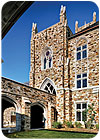
For the Paul Barret Jr. Library at Rhodes College in Memphis, TN, the firm's design utilizes solid pieces of rubble stone, along with Indiana limestone and Vermont slate.
SW: What type of granite was used for that project
Ericson:It was New York's Lake Placid Blue, and the white [granite] was a more standard [stone]. I remember the Lake Placid Blue was a race with Mother Nature, because they were quarrying, and they were running out of blue and going into green. So, it is exciting.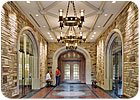
The use of rubble stone continues for the interior of the Paul Barret Jr. Library, where it is complemented by Vermont slate.
SW: You had mentioned the craft of making stone. What are some of the ways that stone is detailed, in that you show the craftsmanship and earthiness of it?
Jackson:In the case of the Paul Barret, Jr. Library at Rhodes College [in Memphis, TN] - where the stone has been mottled and you get to see the way it has been sculpted - in my mind becomes the way that you are able to see something that is unique about the material. When it is used in a plainer fashion, it's more of a surface treatment. It's because the craft isn't the part that is the opportunity. It's the light playing on the surface that you are after, and you jettison your notion of representing either continuity with history or the craft possibilities of the stone. So in the case of Rhodes Library, the trim and the stone itself are mottled. You have a much more ambitious agenda about the building's form and massing with the feeling that we can develop a really elaborate vocabulary around the material's character.Kearns:That's where design and detailing in the stone industry is available to us. We work really closely with craftspeople that come here or we go to them. We always talk about what we are proposing, and to see if it is feasible, and can we afford it, and how will it get done. There is quite a bit of support and knowledge out there that I don't know exists in every other area, but I think in stone, in particular, there is such a long history and some great resources. And that helps you, I think, to tell the story to your clients and also to the contractors and construction managers that this is really feasible. What we are talking about, we have tested.
SW: Is it from the stone supplier end or the masons or a combination?
Kearns:For me right now, it is a combination. I am working at Duke University, which is a combination on the exterior of Indiana limestone and Duke Stone. They have their own quarries, as you probably know. So you have the one or two favorite masons that handle all the Duke Stone projects, who bring an incredible knowledge base to the project right up front. And in the limestone category as well, understanding that material so well, and then figuring out how you bring them together. In that case, you have a sophisticated client that knows that the design team needs to work together with these craftspeople. So you end up with a lot of confidence early on in the project. With that, comes some ability to control cost.
A combination of “Duke Stone†and Indiana limestone are the defining elements of the firm's work at Duke University. The rough-faced “Duke Stone†is quarried locally in North Carolina.
SW: Do you go to the quarries often?
Ericson:For the Lake Placid project we did, and also for Boston College. I didn't personally go for Boston College, but someone else from the team went to the quarry. As you are saying, these people have been doing it for years, and they know how to put it together - from a seven-stone pattern to a five-stone pattern - and they play all the ins and outs of it.Kearns:At Duke, there is a more historic side and a more contemporary side. And within this materials palette, you can kind of stretch to both of those things. You think; can you create a vision that is pretty complex in terms of how you build something like that? At the beginning of the project, the client can say, “This is what we are interested in.†And we say, “This is what we can get.†Then you think, “Can we really pull it off?†I think you need that integrated design process that brings together all the members of the team, including the people in the field and the people in the quarries to figure it out.
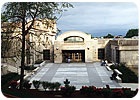
For the Tisch Library at Tufts University in Medford, MA, SBRA's design included limestone as well as granite.
SW: What is the process of specifying stone? Do you start with an idea of color or, maybe in the case of an institutional or educational project, you know from the beginning that you will use stone? Then, how does it progress that you are actually determining sizes, pieces and quantities?
Jackson:At the Rhodes campus, [the stone] was the palette of materials, and the given ways of detailing. We were working in association with another architect that had done buildings for the college, but not buildings with this kind of program. And so, there were those who were well educated in terms of the putting the building together and the details. Our job was to come up with this sort of compositional character. We were in an academic culture that's invested in this character and quality, and has the source for the materials and the contractors that had been on the other buildings on campus. So you are able to maintain quality and character because there is this community of people that solved the problem.Ericson:From my point of view, it depends. Boston College had their stone. There was no question. It was a beautiful stone. It had greens, blacks and yellows in it. They also had an opinion if it should be a five- or seven-stone lay up. They had such an opinion that we had to make sure that we didn't see any expansion joints, and it is hard to do in a modern Gothic wall. The other extreme was Deaconess, where we had the luxury of looking at a range of colors from all over the country. It was a matter of looking at the colors and studying their relative smoothness, their shine, their textures and their colors - also what kind of pattern we wanted to have. The client sometimes tells you what you are going to use, and other times you have a chance at negotiation.
Kearns:We are working right now at John Hopkins - a Georgian campus with Danby White [marble] trimmings. It's just fabulous. It's a beautiful campus with 14-foot-high Danby White columns. They are all so sensuous. The light comes from within. It's just an unbelievable material. [But], we can't do that anymore, which is fine, because it represents a challenge. “How do you create a new architecture that evokes the past, but reinterprets it?†We can't afford to approach those problems and opportunities in the exact same way that was done in the past - and maybe we don't necessarily want to. So we found new ways to integrate marble and brick together that connect to the past, but also create a new expression for the campus, which is energizing to them. That whole experience has been a good one.
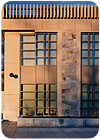
The Tisch Library is considered to be one of the architectural landmarks at Tufts University, with the school offering tours on a regular basis.
SW: Do you find that your clients are sometimes hesitant to try something different?
Kearns:It's a process of working with them and testing and mocking up. Also, examining other materials. We had actually looked at the Danby product versus other white marbles. “Is that a possibility?†We went through that process. We looked at marble from Georgia. That's a practical exercise.Jackson:I've worked with clients before that had a strong sense of the material and a particular stone that they wanted to use in the lobby. We did this building here, where our office is, and there was a strong desire - on the part of the client - to use French limestone in the lobby. The challenge was “How could we create a detailing in it that was contemporary, while again getting at the variation in the color and that kind of thing?â€
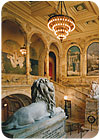
SBRA has been responsible for a broad range of renovation and restoration work at the Boston Public Library, including extensive conservation of the stonework.
SW: You work on different project types. To what degree do you find that your clients want to be available, and have the knowledge of natural stone and how it can be used?
Kearns:We have a group that works with complex institutions that have complex communities. These groups all have a stake, and all want to have a say, so that is always an interesting part of our projects. I think on some of our projects, our clients are pretty sophisticated in regards to material and material selections.Jackson:I have to say that largely academic clients have a strong sense of tradition and the use of stone.
SW: From a practical standpoint, do they understand costs?
span class="staticbold">Jackson: There's no way you are going to use stone and not know what you are getting in to. It was wonderful that on the Rhodes College project I had the chief financial officer in my corner.Ericson:I do think that within the constituencies, the facilities people - the ones that roll up their sleeves - are just as interested. Not just from a maintenance point of view, but because it is somehow tactile, and somehow what they work with, as the trustees are who are willing to go out in the snow to look at a mock-up because it is just that important to them. I think though that the knowledge they have is different. The trustees will have knowledge of prestige and distinctiveness, and how the whole campus is going to be enhanced. And the people in the facilities department are saying, “You know, the seven-stone pattern wasn't the best. We've had a lot of trouble with that.†And so, you have that hands-on feedback. Therefore, it is a very rich spectrum of understanding and knowledge, and you need to use all of it.
Jackson:In that setting, we are dealing with clients that build a lot. It's when you are dealing with a client that hasn't built before - then it is a different world.
Kearns:There is also an expectation that we are educating them, so we need to be sharing within our community - to have access to the innovations in this area so that we can bring that to our clients. “Are there innovations in quarrying that can help with cost?†We found that out at Duke. They can change the way they are quarrying, which brought down the cost, and allowed us to use more of the product on the project.
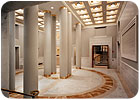
The “Northwest Corridor†design at Boston Public Library serves as a bridge between the historic architecture of Charles Follen McKim and a 1972 addition by Philip Johnson.
SW: Do they also educate or explain to you some of the changes in the technology of cutting and fabricating stone? Is it being communicated that there is machinery that reproduce some details? How does the stone industry deal with that?
Ericson:We take field trips. I went to Rhode Island to look at stone. It was worth a thousand words. You can really see how they do it.Kearns:I think there is room for more exposure to what is on the cutting edge of the industry. I feel like now and then I catch some of the highlights and sound bites, but I don't feel really immersed in it.
Ericson:I would like to feel like people are proactive about the possibilities of stone and its modern techniques - but being more proactive, rather than waiting for us to have a project. Sometimes you don't have the faintest idea how exciting this stuff can be.
SW: Staying in that vein, does the industry do a decent job of telling you what is out there and what is available?
Ericson:Many clients will say, “Is this the first time this has ever been done or where has this ever been done before?†And often, we don't have an answer. So, helping us analyze and have data about new material, and how they are used, would be very helpful.Kearns:I think we are under pressure - like everyone - to have things faster and better and more efficient and better communicated. That's our world. So the more information we have about new products and new approaches, such as customer success stories or a contact that we can talk to for references, would help.
Ericson:We need all the help we can get to make the case for new materials.

Stone was used for the flooring as well as vertical surfaces at the Boston Public Library's Northwest Corridor.
SW: What have been some positive experiences of working with stone? What projects were you particularly pleased with the way the stonework came out?
Ericson:The thing about Boston College is that the stone of the original building was kept inside as an inside facade. The whole atrium color scheme is derived from the color of the stone. That created a warmth and vital experience, visually. This is so integrated and so organic, that it is just beautiful. I am particularly proud to bring the stone and other materials into harmony with color.Jackson:Tufts University had the original lobby that was all done in limestone. We were able to do an addition using granite. The original building was so poetic. In one sense, it was like a mausoleum. We were able to recycle the limestone from the existing building and make it an architectural ornament and then weave granite into that. So that became a pretty powerful expression.
Kearns:I had a recent success using stone inside the buildings of a couple projects. At Duke, and also at the Boston Public Library - using it to frame openings, case openings and to create beautiful thresholds. Sometimes, in some of our academic work, we will have big zones of carpet. We begin to try and define those spaces with stone base and stone flooring materials and stone portals, which really just accentuates the sense of quality.
Jackson:When dealing with a client that is price sensitive, one of the areas where one can guarantee that you will have success in introducing stone is where there is going to be a maintenance issue. So the base of the building being stone or the floor being stone in the public spaces - being able to add both character and quality of the space, but also deal with the maintenance issue of people arriving. That's a place where you can establish an identity, while serving what's really a basic maintenance issue.
Ericson:From my point of view, I think the color of stone is what really makes it different from almost anything else you can deal with. I like the idea that it is unique and contributing to the sense of architecture. You just can't substitute for it without loosing something in addition, and I think that is important for people to get.

Rough-faced stone was also used for the William D. Walsh Family Library at Fordham University in New York.
SW: On the other side, what have been some negative experiences that you have had working with stone?
Ericson:I had one. I specified Texas granite. It was pretty uniform and had a rich color. All of a sudden, one day, there were some little black spots on a couple of tiles. Then the little black spots got a little bigger, and there were more of them. So finally, I went out to where all of the material was being shipped. They had hit some spot in the quarry, and this black spot turned into a splotch. I told them that our specifications said that these spots can be no more than four on a tile, and no bigger than my thumb. It was really difficult because the quality control was out of control, and it had already been shipped from Texas. It was really hard to negotiate, but our spec was pretty well written. That was a very hard experience, but it was long ago, and I learned from it. It was memorable.SW: Did you have to sort the tile so that the most blemished pieces were elsewhere?
Ericson:No, we got new stone. Our spec was tight enough to say that this was not intended. A mock-up also helps, because when the material is up on the mock-up you say, “This is what we approved, and this is what you are giving us. There is not much alignment here.†But that's one of the factors of working with any stone. You cannot control Mother Nature. You have to decide, “Can we make it beautiful anyway?†Stone is inherently beautiful, but sometimes you get what you hadn't counted on.Kearns:I had a few accounts where I couldn't get control of the cost information in a way to close the deal, and get everyone to sign up. That happened in Philadelphia, where we wanted limestone and couldn't quite get there for whatever reason. Maybe if there is a way to start to pool some of the knowledge and resources, it will help.

The size and color range of the stone used at Fordham University adds visual interest to the project.